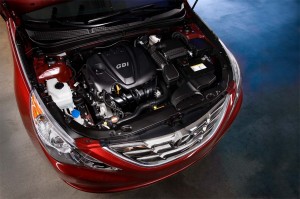
Hybrids offer plenty of promise but advanced -- and downsized -- engines like this Hyundai I4 will keep gasoline power competitive.
Despite all the talk of electric vehicles and hydrogen fuel cells, industry insiders agree that the internal combustion engine will remain the choice for powering the world’s cars for the foreseeable future.
With that in mind, a group of experts gathered by the National Research Council (NRC) looked at ways to improve fuel economy using the same basic engine design that has powered cars since the 19th century, specifically, the spark ignition gasoline engine. Members of the committee presented their findings at a breakfast sponsored by the Center for Automotive Research (CAR).
Trevor Jones, who headed the study, said other power sources, such as electricity and fuel cells still present challenges engineers and scientists have not been able to overcome. In addition, the low cost of oil will help keep the SI engine the dominant powerplant for at least the next 15 years.
Automakers already know that they will have to improve fuel economy with new Corporate Average Fuel Economy standards being phased in starting in 2012. A maker’s fleet average will have to be about 34.1 mpg by 2016.
Most automakers are looking at three potential tracks for improved fuel efficiency: diesel, hybrid and improvement of the basic SI engine, said Chris Baillie, project manager for FEV Inc., a global engineering company.
The committee’s research showed that of the three competing paths for increased fuel efficiency, hybrids offer the greatest potential for increased fuel efficiency, but at significantly greater cost, Baillie said. A hybrid’s efficiency could be increased by nearly 44%, but at a cost of more than $6,000. An SI engine’s efficiency could be improved by 29% at a far more reasonable cost of $2,169. Diesels were close to the numbers for the hybrids with a 37.5% improvement projected to cost $5,905.
The study began in 2007 and was the first since a 2002 report addressed the same basic issue.
Jones said that the engineers already know plenty of tricks to improve automotive efficiency. The problem is money.
“Over the 15-year time horizon of the study, improvements in fuel economy are not technology limited by cost constrained,” he said.
Linos Jacovides, CEO of Paphos LLC and retired from Delphi Research Laboratories, said the experts know that customers expect these more fuel-efficient vehicles to maintain the current standards for space and performance.
Like a lot of experts, Jacovides is eager to see the Chevrolet Volt perform in a real-world environment.
“It will be very interesting to see how the Volt behaves,” Jacovides said. GM calls the Volt an extended-range electric vehicle. When it launches later this year, the Volt will be capable of traveling up to 40 miles on battery power before switching over to an onboard gasoline engine, giving the car a range of up to 300 miles.
While Japanese and U.S. automakers have focused on hybrids and improving gasoline engines, European manufacturers have invested heavily in diesel technology. About 50% of the cars sold in Europe have diesel engines.
Krieger said the committee studied vehicles offered in Europe with gasoline and diesel engines that have comparable performance numbers and found that diesels are about 25% more efficient than gasoline engines for vehicles with similar performance.
Jay Baron, CAR’s president and CEO and the organization’s director of manufacturing, engineering and technology group, said one way to reduce fuel consumption would be using lighter materials such as aluminum, magnesium, titanium and plastics. But the key, he said is matching engine performance to the lighter vehicle. In fact, he said a 10% reduction in vehicle mass would yield just 6% improved fuel economy.
“If you just reduce mass and don’t do anything else, you’re not realizing the full benefit,” he said.
Part of the problem is most auto factories are set up to weld steel, but forming and joining advanced materials is more difficult and costly.
Other ways to improve fuel efficiency include better aerodynamics, which could be improved with low-cost covers under the car and in the wheel wells, Baron said.
Engineers are also looking at two relatively new transmission types, the dual-clutch automated manual and the continuously variable transmission to help improve fuel economy. Dual-clutch transmissions trade power-robbing torque converters for computer-controlled clutches but are expensive and are not as smooth as traditional automatics. CVT are cheaper but have performance issues, particularly related to high-torque applications such as for towing.
In the end, it all comes down to the price of oil, Jacovides said.
“Unless something drastic happens to the price of oil, these technologies will be very slow to come up.”
Bryan Laviolette is founder and editor of http://amphibiouswllz.com. E-mail him at laviolette.autoscribe@yahoo.com
